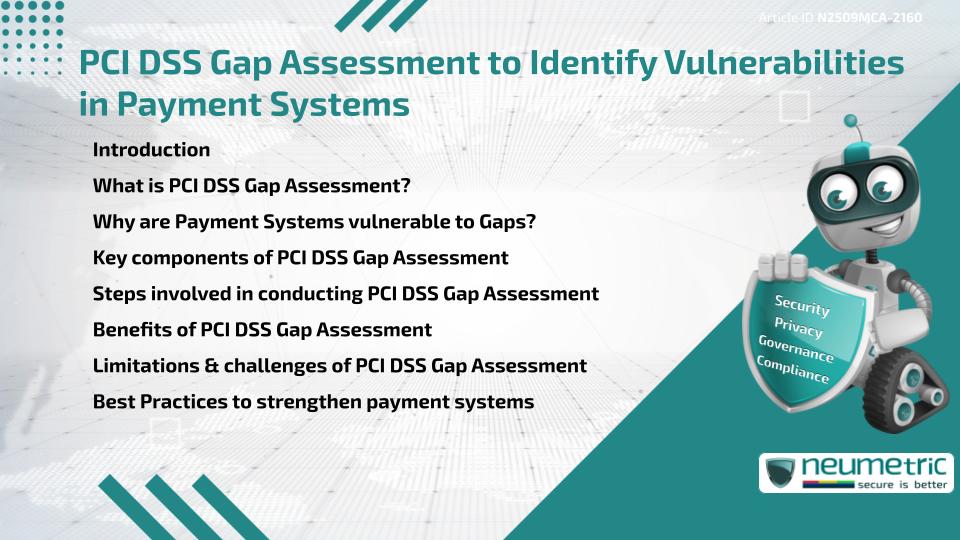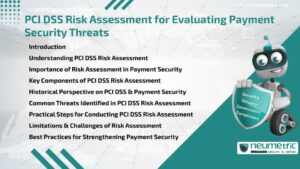Table of Contents
ToggleIntroduction
A PCI DSS Gap Assessment is a structured process that identifies security weaknesses in payment systems before they can be exploited. It compares an organisation’s current Controls against the Payment Card Industry Data Security Standard [PCI DSS] to highlight deficiencies. By doing so, it helps Organisations understand where they fall short of Compliance & where their payment data may be exposed to Risks. From cardholder Data Security to system monitoring, the Assessment plays a crucial role in safeguarding Financial transactions.
What is PCI DSS Gap Assessment?
A PCI DSS Gap Assessment is a proactive review of an organisation’s existing Security Measures against the twelve (12) core requirements of PCI DSS. It does not grant official Certification but provides a clear roadmap to Compliance. Think of it like a practice exam that highlights weak areas before the final test. By identifying these shortcomings, businesses can take Corrective Actions before undergoing a full Audit.
Why are Payment Systems vulnerable to Gaps?
Payment systems handle Sensitive Information such as card numbers, verification codes & expiration dates. Any gaps in security could expose this data to cybercriminals. Vulnerabilities often arise from outdated software, weak encryption methods or improper Access Controls. For example, if an Employee has unnecessary administrative privileges, it could lead to data exposure. These small Gaps are exactly what attackers exploit, making regular assessments vital.
Key components of PCI DSS Gap Assessment
A PCI DSS Gap Assessment usually focuses on:
- Access Control: Ensuring only authorised individuals can access payment systems.
- Network Security: Protecting systems through firewalls, intrusion detection & secure configurations.
- Encryption: Safeguarding data in transit & at rest.
- Monitoring & Testing: Logging activity & testing systems regularly.
- Policies & Procedures: Establishing clear rules for data handling & staff training.
Together, these components provide a holistic view of payment system security.
Steps involved in conducting PCI DSS Gap Assessment
The process of conducting an Assessment typically follows these steps:
- Scope Definition: Identifying systems, processes & data flows that involve Cardholder data.
- Data Collection: Reviewing System Logs, Configurations & Policies.
- Gap Identification: Comparing current practices against PCI DSS requirements.
- Risk Prioritisation: Ranking Vulnerabilities by severity & potential impact.
- Remediation Planning: Creating action steps to close the Gaps.
This structured approach ensures Organisations address critical Risks first while working towards full Compliance.
Benefits of PCI DSS Gap Assessment
Performing a PCI DSS Gap Assessment offers multiple benefits:
- Early detection of Vulnerabilities.
- Reduced Risk of Data Breaches.
- Increased confidence from Customers & Business Partners.
- Clear roadmap for Compliance Audits.
- Improved Employee awareness of security Best Practices.
In essence, the Assessment not only improves Compliance readiness but also enhances trust & security posture.
Limitations & challenges of PCI DSS Gap Assessment
While highly valuable, a PCI DSS Gap Assessment has certain limitations. It provides a snapshot in time & may not cover emerging Threats. Smaller Organisations may also find it resource-intensive. Additionally, the results depend on the accuracy of the information shared during the Assessment. If incomplete data is provided, the findings could be misleading.
Best Practices to strengthen payment systems
To maximise the value of a PCI DSS Gap Assessment, Organisations should adopt Best Practices such as:
- Keeping software & systems updated.
- Regularly training Employees on Data Security.
- Implementing Multi-Factor Authentication for System Access.
- Conducting periodic Vulnerability scans & Penetration tests.
- Documenting & Reviewing all Security Policies.
These practices ensure that identified gaps are effectively closed & future Vulnerabilities are minimised.
Conclusion
A PCI DSS Gap Assessment acts as a powerful tool for Organisations to identify & fix Vulnerabilities in payment systems. By mapping current practices against PCI DSS requirements, businesses gain clarity on where improvements are needed. Although not a certification, it offers a practical roadmap to Compliance & better protection of Sensitive Data.
Takeaways
- A PCI DSS Gap Assessment compares existing controls with PCI DSS requirements.
- It identifies Vulnerabilities in payment systems before they are exploited.
- The Assessment offers a roadmap to Compliance & Data Protection.
- It should be complemented with Continuous Monitoring & Best Practices.
FAQ
What is the purpose of a PCI DSS Gap Assessment?
Its purpose is to identify weaknesses in payment system security & prepare Organisations for PCI DSS Compliance.
Does a PCI DSS Gap Assessment provide certification?
No, it does not. It only highlights areas for improvement to help Organisations prepare for formal Audits.
Who should conduct a PCI DSS Gap Assessment?
Ideally, trained Security Professionals or Third Party Assessors with knowledge of PCI DSS requirements should conduct it.
What types of Vulnerabilities can be identified?
It can uncover Gaps in Access Control, Network Security, Encryption, Monitoring & Policy Enforcement.
Is a PCI DSS Gap Assessment suitable for Small Businesses?
Yes, although resource constraints can be a challenge, it is essential for protecting Customer Payment Data.
How does it differ from a Vulnerability scan?
A Vulnerability scan identifies technical weaknesses, while a PCI DSS Gap Assessment evaluates Compliance with broader security requirements.
Can Employees play a role in closing gaps?
Yes, through training, awareness & adherence to Security Policies, Employees are vital in reducing Risks.
Need help for Security, Privacy, Governance & VAPT?
Neumetric provides organisations the necessary help to achieve their Cybersecurity, Compliance, Governance, Privacy, Certifications & Pentesting needs.
Organisations & Businesses, specifically those which provide SaaS & AI Solutions in the Fintech, BFSI & other regulated sectors, usually need a Cybersecurity Partner for meeting & maintaining the ongoing Security & Privacy needs & requirements of their Enterprise Clients & Privacy conscious Customers.
SOC 2, ISO 27001, ISO 42001, NIST, HIPAA, HECVAT, EU GDPR are some of the Frameworks that are served by Fusion – a SaaS, multimodular, multitenant, centralised, automated, Cybersecurity & Compliance Management system.
Neumetric also provides Expert Services for technical security which covers VAPT for Web Applications, APIs, iOS & Android Mobile Apps, Security Testing for AWS & other Cloud Environments & Cloud Infrastructure & other similar scopes.
Reach out to us by Email or filling out the Contact Form…





